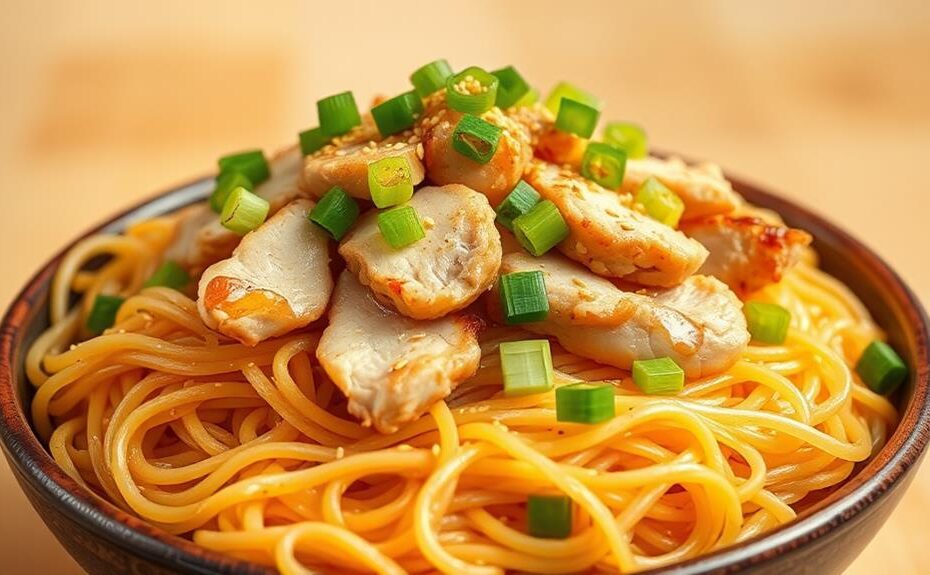Mastering Chicken Pancit Bihon in 10 Easy Steps
Step 1: Prepare Ingredients
Gather bihon noodles, chicken, carrots, cabbage, onion, and garlic. Cut ingredients into uniform pieces for even cooking.
Step 2: Soak Bihon Noodles
Soak bihon noodles according to package instructions.
Step 3: Cook Chicken and Aromatics
Cook chicken and aromatics like onion and garlic until the chicken is fully cooked.
Step 4: Add Vegetables and Seasonings
Add carrots and cabbage to the cooked chicken and aromatics. Add seasonings in the right order to bring out the flavors.
Step 5: Combine Noodles, Chicken, and Vegetables
Combine cooked bihon noodles, chicken, and vegetables.
Step 6: Add Soy Sauce and Water
Add soy sauce and water to the combined mixture.
Step 7: Stir-Fry to Perfection
Stir-fry the mixture until the flavors are fully incorporated and the noodles are well coated.
Step 8: Garnish with Fresh Herbs
Garnish with fresh herbs like green onions or parsley.
Step 9: Serve Hot
Serve the Chicken Pancit Bihon hot.
Step 10: Enjoy Your Masterpiece
Enjoy your flavorful and visually stunning Chicken Pancit Bihon, a classic Filipino dish.
Prepare Ingredients and Noodles
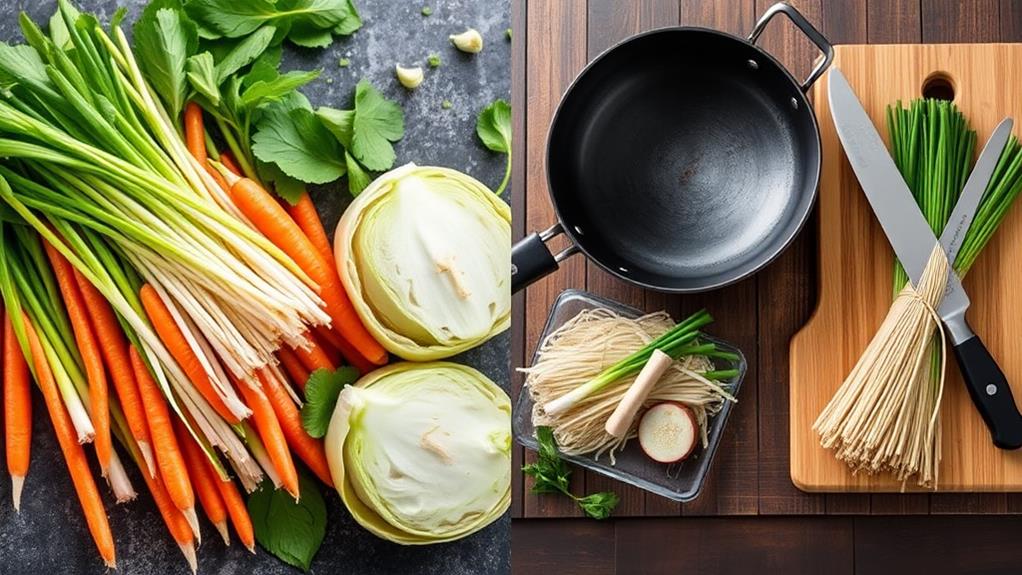
Gather Ingredients
To prepare for cooking pancit bihon, collect all necessary ingredients, including bihon noodles, chicken breast, carrots, cabbage, onion, and garlic.
This ensures an organized cooking process and saves time later on.
Prepare Chicken
Thinly slice the chicken breast into bite-sized pieces to allow for quick and even cooking during stir-frying.
This is crucial because unevenly cooked chicken can be a major turn-off in any pancit bihon recipe.
Prepare Vegetables
Julienne the carrots and shred the cabbage to create uniform pieces that will cook evenly and add a colorful crunch to the dish.
Soak and Cook Bihon Noodles
Soak Bihon Noodles Correctly
To achieve the perfect texture, bihon noodles must be soaked correctly. Soak the noodles in warm water for 10-30 minutes, or until they become soft and pliable. This allows for easier cooking later.
The soaking time depends on the noodle thickness, with thinner noodles requiring less soaking time.
Drain and Set Aside
After soaking, drain the noodles to prevent clumping. Set them aside before mixing them with other ingredients in the stir-fry.
Properly soaked noodles absorb flavors from the sauce and other ingredients during cooking, enhancing the overall taste of the dish.
Cook Bihon Noodles
Cook the noodles according to the package instructions to achieve the perfect texture. This ensures that the noodles are cooked correctly and ready for the chicken pancit bihon dish.
Sauté Aromatics and Chicken
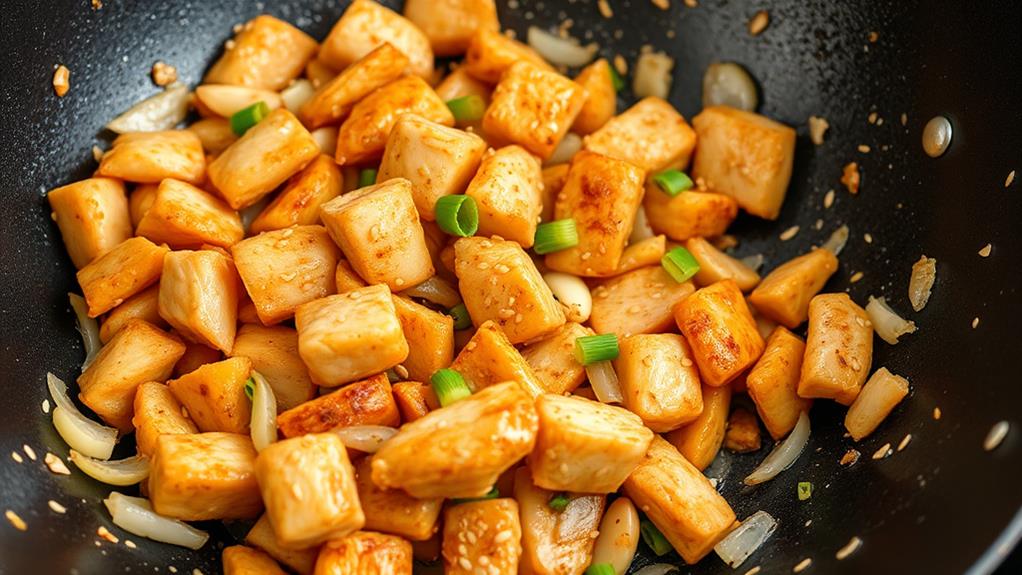
Heating oil in a wok or large pan over medium heat sets the stage for even cooking of the ingredients, allowing you to carefully sauté aromatics and chicken that will eventually harmonize with the cooked bihon noodles.
Sautéing onions and garlic is the first step in building flavor. Finely chop onions and mince garlic, then sauté them until they're fragrant and translucent.
Stir frequently to prevent burning, which can ruin the dish.
Adding chicken breast comes next. Slice the chicken thinly and add it to the pan, cooking until it turns golden brown and is no longer pink in the center, which typically takes about 5-7 minutes.
Season with salt and pepper during cooking to enhance the chicken's taste and complement the other ingredients.
Stir frequently to ensure the aromatics don't burn and the chicken cooks evenly throughout. This step is crucial in building the foundation of flavors for your Chicken Pancit Bihon.
Add Vegetables and Seasonings
Add Vegetables and Seasonings
With your aromatics and chicken perfectly cooked, it's time to introduce colorful vegetables and savory seasonings to elevate your Chicken Pancit Bihon.
Adding Vegetables
To add vegetables, sauté them in the order of their cooking time, starting with onions and garlic for flavor, followed by harder vegetables like carrots, and finishing with softer ones like cabbage. Sautéing order and cooking times:
| Vegetable | Cooking Time |
|---|---|
| Onions and Garlic | 2-3 minutes |
| Carrots | 3-4 minutes |
| Bell Peppers | 2-3 minutes |
| Cabbage | 1-2 minutes |
| Others (e.g., mushrooms) | 2-3 minutes |
Incorporating Julienned Vegetables
Incorporate julienned carrots, shredded cabbage, and bell peppers to enhance the dish's flavor and nutritional value.
Adding Seasonings
Use key flavor enhancers: soy sauce and oyster sauce, adding them gradually to control the flavor intensity and ensure an even coating on the noodles and vegetables. Additional seasonings: consider adding a sprinkle of black pepper and chicken bouillon powder to deepen the umami flavor profile of the dish. Stir-fry goal: stir-fry the vegetables just until they are tender-crisp to maintain their vibrant color and crunch, which adds texture to the final dish.
Cook Chicken and Vegetables
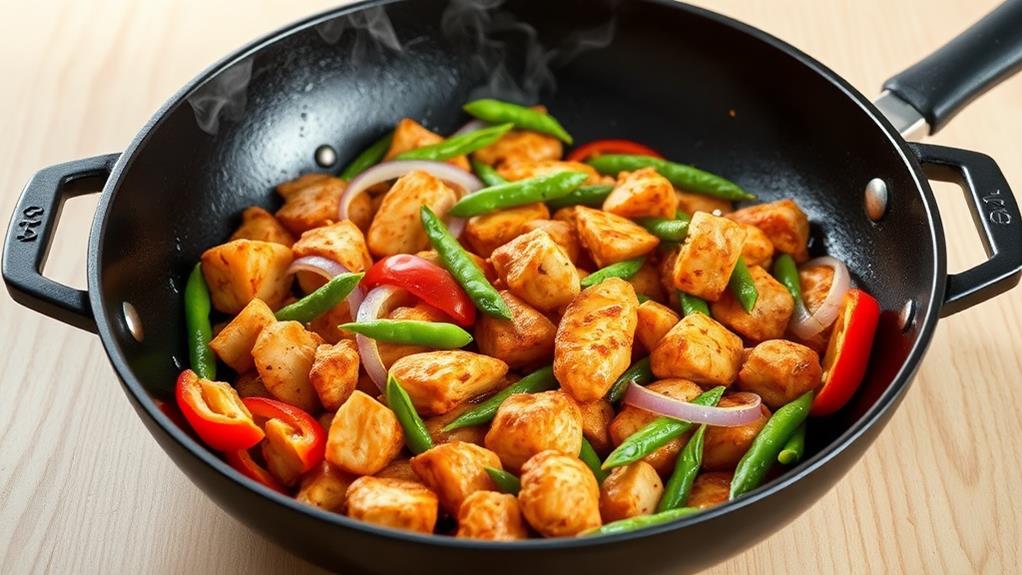
Cook Chicken and Vegetables
To prepare the chicken, boil two pounds of bone-in chicken until fully cooked. This step enhances the flavor and creates a rich broth for the dish.
Once cooked, shred the chicken and reserve the broth to keep the meat tender and flavorful.
Sauté Aromatics and Vegetables
To build a flavorful base, sauté minced garlic and onion in oil until fragrant.
Then, add julienned carrots and shredded cabbage and stir-fry until they're tender but still crisp. This step maintains texture and color in the vegetables.
Combine Chicken and Vegetables
Finally, mix the shredded chicken with the sautéed vegetables, allowing them to absorb the flavors.
This step creates a harmonious balance of flavors and textures in the dish.
Combine Noodles and Sauce
Combining Noodles and Sauce
Once the bihon noodles are softened, drain them thoroughly to remove excess moisture.
In a large wok, combine the cooked chicken and sautéed vegetables with the prepared sauce mixture, which typically includes soy sauce and oyster sauce to enhance the flavor.
Add the drained bihon noodles to the wok, ensuring they're evenly distributed among the protein and vegetables for a uniform taste.
Toss everything together gently with tongs or a spatula, allowing the noodles to absorb the sauce while ensuring they don't break apart.
Stir-fry for an additional 3-5 minutes until the noodles are heated through and have taken on the flavors of the sauce and other ingredients.
Add Soy Sauce and Water
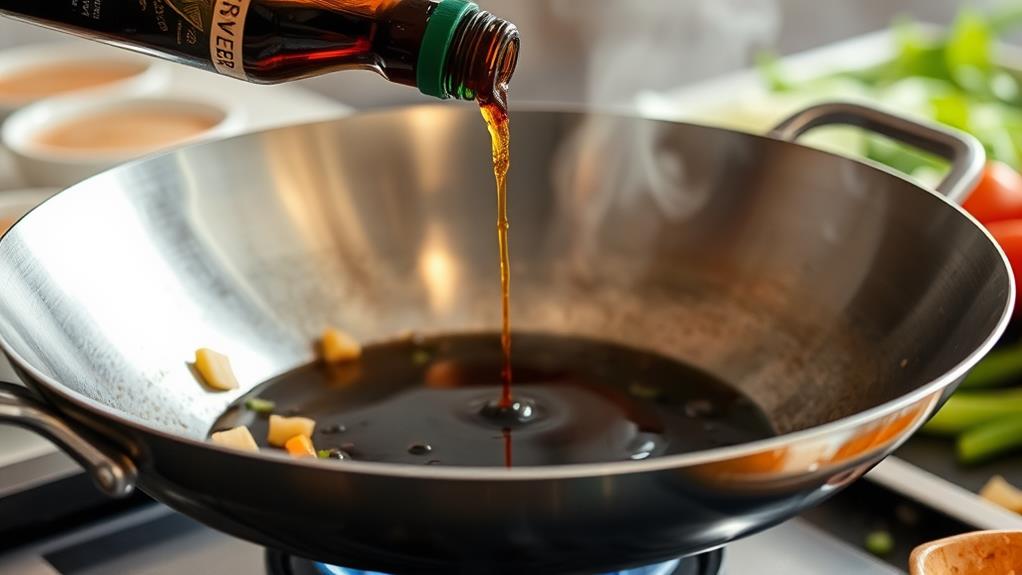
Add Soy Sauce and Water
To enhance the flavor profile of your Chicken Pancit Bihon, add 5 tablespoons of soy sauce to the pan. This provides the essential flavor base for the dish, bringing depth and umami flavor to your Pancit.
Next, add 1 to 1.5 cups of water to ensure the noodles have enough liquid to absorb while cooking. Stir the soy sauce and water mixture well to evenly coat the vegetables and chicken, enhancing the overall flavor profile.
Allow the mixture to simmer for a few minutes, enabling the flavors to meld before adding the soaked bihon noodles. This brief simmering process helps the flavors integrate seamlessly.
Once the noodles are added, toss everything together, ensuring the noodles are thoroughly coated with the soy sauce and water for optimal taste.
Stir-Fry and Serve Hot
Heat Oil and Sauté Aromatics
Heat oil in a wok or large skillet over medium-high heat.
Then, sauté minced garlic and onion until fragrant, which creates a flavorful base for the dish.
Cook Chicken
Add sliced chicken breast and cook until browned and no longer pink, ensuring the meat remains tender and juicy.
Stir-Fry Vegetables
Incorporate julienned carrots and shredded cabbage, stir-frying for a few minutes until the vegetables are slightly softened but still crisp for added texture.
Combine Noodles and Sauces
Add the soaked bihon noodles along with a mixture of soy sauce and oyster sauce.
Toss everything together until the noodles are evenly coated and heated through.
Garnish and Serve With Fresh Herbs
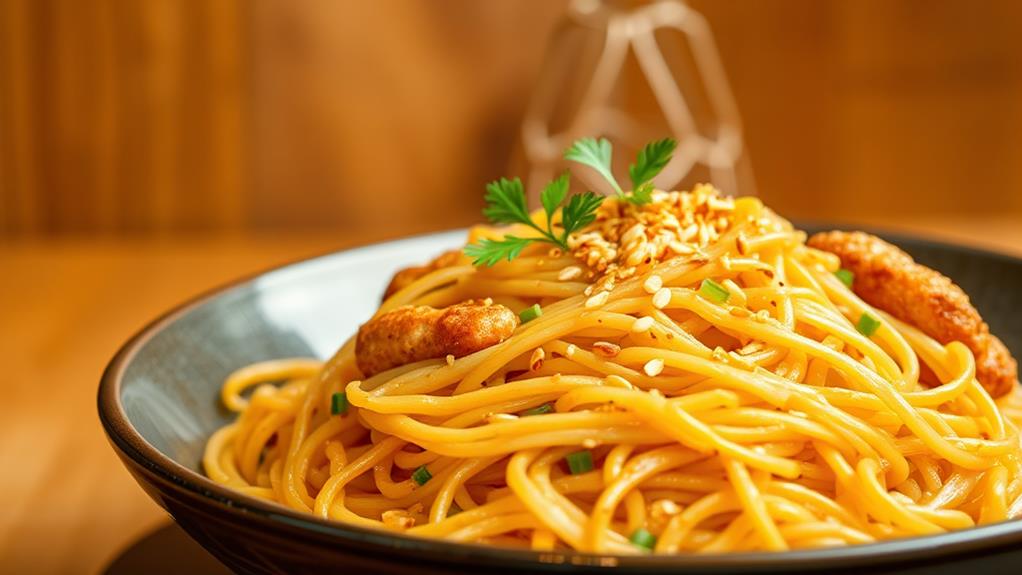
Elevate your Chicken Pancit Bihon with thoughtful garnishes that balance and refresh the rich, savory flavors.
Freshly chopped green onions add a pop of color and a mild onion flavor that complements the dish's savory profile.
Additionally, fresh cilantro or parsley can be sprinkled on top to introduce a refreshing herbaceous note, enhancing the overall taste experience.
A squeeze of calamansi or lemon juice right before serving brightens the flavors and adds a zesty contrast to the rich noodles.
Toasted sesame seeds can be scattered over the dish for added texture and a nutty flavor that pairs well with the soy sauce-based seasoning.
Serving with a side of fresh herbs allows diners to customize their dish, balancing the savory elements with fresh, aromatic notes.
Are the Steps for Mastering Chicken Pancit Bihon the Same as the Easy Steps for Chicken Pancit Bihon?
Yes, the mastering chicken pancit bihon steps are the same as the easy steps for chicken pancit bihon. The key to a delicious chicken pancit bihon lies in proper preparation and cooking techniques, regardless of the level of difficulty. Following the mastering chicken pancit bihon steps will result in a flavorful and satisfying dish.
Store Leftovers and Reheat
Storing Leftovers
To maintain optimal freshness, store leftovers in an airtight container in the refrigerator and consume them within 2-3 days.
Reheating Methods
Three reheating methods can be used to restore your Chicken Pancit Bihon to its former state:
| Reheating Method | Instructions |
|---|---|
| Microwave | Cover with a lid or damp paper towel and heat for 1-2 minutes. |
| Stovetop | Heat on low, stirring occasionally, until warmed through. |
| Steaming Basket | Heat for 5-10 minutes to preserve noodle texture.
Freezing Leftovers
For longer storage, you can freeze your Chicken Pancit Bihon. Ensure the dish is completely cooled before placing it in an airtight container or freezer bag. Frozen leftovers can be consumed within 1-2 months for the best quality. When reheating, use one of the methods above to restore your dish.
Frequently Asked Questions
How Do You Cook Pancit Canton Steps?
To cook Pancit Canton, follow these steps:
Step 1: Prepare the Noodles
Pancit Canton is a type of noodle-based dish that uses egg or rice flour noodles. Choose your preferred type of noodle and follow the package instructions for soaking and draining.
Step 2: Boil the Noodles
Boil the noodles in water or broth until they're al dente. This will help remove excess starch and prepare the noodles for stir-frying.
Step 3: Prepare the Ingredients
Gather your desired ingredients, such as vegetables, protein (e.g., pork or chicken), and seasonings. Chop the vegetables and cook the protein according to your preference.
Step 4: Stir-Fry the Ingredients
Heat oil in a wok or large skillet and stir-fry the ingredients until they're cooked through. Add the noodles to the wok or skillet and stir-fry everything together.
Step 5: Season and Serve
Add your preferred seasonings and serve the Pancit Canton hot. You can serve it as a main dish or side dish, and it's often paired with other Filipino dishes.
Tips and Variations
Pancit Canton can be customized to suit your taste preferences. Try using different vegetables, proteins, or seasonings to create your own unique flavor profile. You can also experiment with regional variations to learn more about the cultural significance of this dish.
What Is the English Name for Bihon?
Bihon is known as "rice vermicelli" or "rice noodles" in English.
Bihon has a rich history, with variations across Asia. It originated in ancient China and has since evolved, becoming a staple in Filipino cuisine and other cultures.
Rice vermicelli is gluten-free and low in calories, making it a nutritious food option.
Bihon is a versatile ingredient, often used in stir-fries and soups, and served with savory sauces.
For example, it's commonly used in Filipino dishes such as Pancit Bihon, a popular stir-fry dish made with rice vermicelli, vegetables, and meat or seafood.
What Food Goes Well With Pancit Bihon?
Traditional Pairings for Pancit Bihon
When pairing food with pancit bihon, lumpia (spring rolls) is a classic combination that adds a satisfying crunch to the dish.
Another popular option is grilled or fried chicken, which provides a boost of protein and flavor to the meal.
Adding Freshness and Spice
To add some freshness to your pancit bihon, consider pairing it with a fresh cucumber and tomato salad.
For an extra kick, try serving the dish with soy sauce or vinegar with chili. These regional variations can add a new level of flavor to the traditional Filipino dish.
How to Cook Super Q Bihon?
To cook Super Q Bihon, start by preparing the noodles correctly. Soak the bihon noodles in warm water to ensure they absorb the flavors evenly. This step helps the noodles cook uniformly and prevents them from becoming mushy.
Create a flavorful base by sautéing aromatics. Sauté minced garlic and onions in a pan until they're fragrant and lightly browned. This flavor base will enhance the overall taste of your Super Q Bihon.
Customize your dish with protein and vegetables. You can add protein sources like cooked chicken, pork, or shrimp to make your Super Q Bihon more substantial.
Additionally, choose your favorite vegetables, such as cabbage, carrots, or bell peppers, to add texture and flavor variations.
